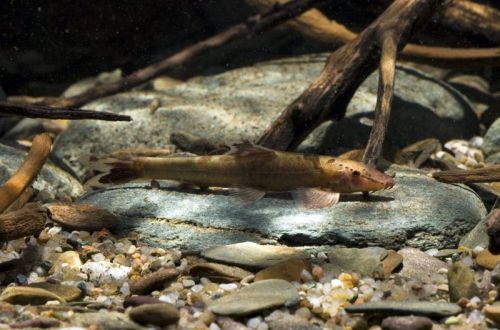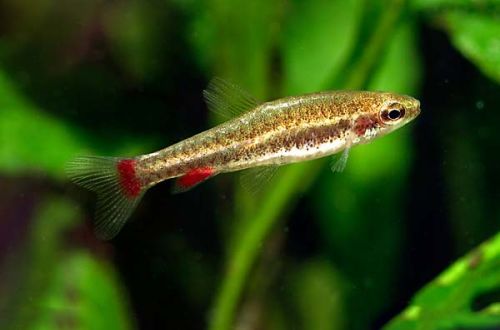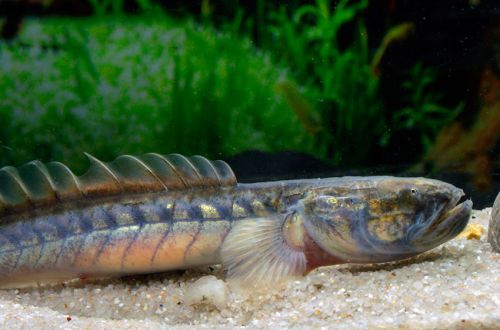
Homaloptera confusona
Homaloptera confuzona, scientific name Homaloptera confuzona, belongs to the family Balitoridae (River loaches). Fish of this group are often found in amateur aquariums, but it can be problematic to determine which species has been acquired due to the similarity in color and body pattern. Maintenance comes with a number of challenges, chief among which is the need for very clean running water and the need to provide internal flow.

Contents
Habitat
It comes from Southeast Asia from the Mekong River basin in what is now Cambodia. Inhabits small streams and rivers flowing through the mountains. A typical biotope is a rather turbulent water stream with stony substrates and numerous snags. Aquatic vegetation in the channel is usually absent, growing mainly along the banks.
Brief information:
- The volume of the aquarium – from 100 liters.
- Temperature – 20-25°C
- Value pH — 6.0–7.5
- Water hardness – soft to medium hard (2-15 dGH)
- Substrate type — stony
- Lighting – moderate or bright
- Brackish water – no
- Water movement – moderate or strong
- The size of the fish is 7–8 cm.
- Food – any food
- Temperament – peaceful
- Keeping in a group of 5-6 fish
Description
Adult individuals reach a length of 7–8 cm. The color is yellowish or red-brown with an ornament of four incomplete dark stripes on the body. The first stroke is in the region of the pectoral fins, the second is triangular at the base of the dorsal fin. The third is located above the base of the anal fin, but may be absent in some individuals. The fourth is on the caudal peduncle.
All types of Homalopters are outwardly very similar and differ only in body pattern. This similarity has led to difficulties in accurately identifying them with each other.
Food
An omnivorous species, in nature they feed on small crustaceans, insect larvae and other invertebrates, as well as algae that grow in abundance on the surface of stones and snags. In a home aquarium, the diet should include protein foods with herbal supplements.
If the fish are kept in a strong internal current, then the choice of food will be limited, since most of the products will be picked up by the current and begin to circulate in the water, polluting it. In this case, it is desirable to use special gel-like or paste-like foods that are applied to decorative elements.
Maintenance and care, arrangement of the aquarium
The optimal size of the aquarium for a group of 5-6 fish starts from 100 liters. The height of the tank should not be large, even 30 cm is enough. With the long-term content of Homalopter confuson, it is important to provide clean running water rich in dissolved oxygen, and a moderate or strong current that imitates a stormy mountain stream in which fish live in nature. The recommended movement of water should be 10-15 revolutions per hour, i.e. for a volume of 100 liters, an internal filter with a capacity of 1000 liters per hour will be required.
It is worth remembering that water quality depends not only on the smooth operation of the filters, but also on the regularity of a number of mandatory aquarium maintenance procedures. These include: weekly replacement of part of the water (30–40% of the volume) with fresh and timely removal of organic waste (feed residue, excrement).
The design is extremely simple and includes a ground of stones, boulders interspersed with snags and other decor. Live aquatic vegetation is not required, but unpretentious varieties of anubias, aquatic mosses, and ferns can be used if desired.
Behavior and Compatibility
Peacefully tuned to each other, no intraspecific conflicts were noted. They prefer to stay in groups, so it is worth buying at least 5-6 individuals. As neighbors, you should choose fish that can live in similar conditions with strong water movement.
Breeding / breeding
At the time of preparing the materials for this article, the authors could not find reliable information about the successful breeding of Homaloptera confuson in home amateur aquariums.
Fish diseases
Health problems arise only in case of injuries or when kept in unsuitable conditions, which depresses the immune system and, as a result, provokes the occurrence of any disease. In the event of the appearance of the first symptoms, first of all, it is necessary to check the water for the excess of certain indicators or the presence of dangerous concentrations of toxic substances (nitrites, nitrates, ammonium, etc.). If deviations are found, bring all values back to normal and only then proceed with treatment. Read more about symptoms and treatments in the Aquarium Fish Diseases section.





